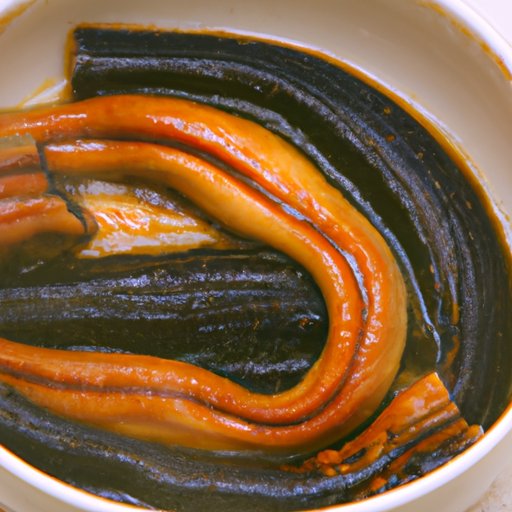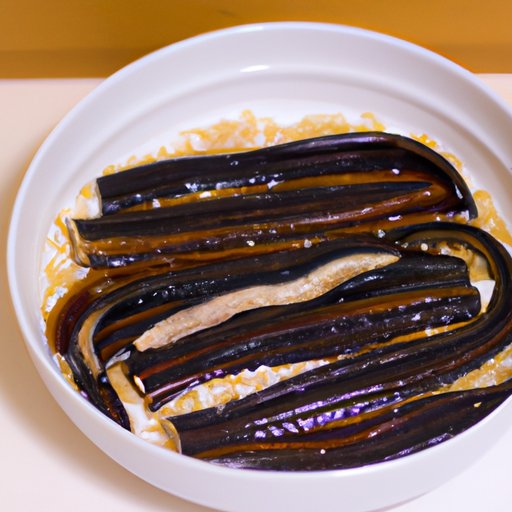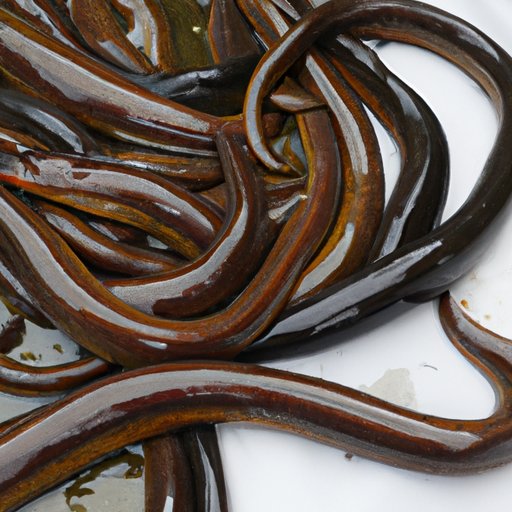Introduction
Eel is a tasty, nutritious fish that has been enjoyed for centuries. In fact, it is one of the oldest known species of fish. It is an important food source in many cultures and is highly sought after by chefs around the world. But is eel healthy? This article will explore the health benefits and risks associated with eating eel and provide tips on how to prepare and enjoy it safely.

Exploring the Nutritional Benefits of Eating Eel
Eel is an excellent source of protein, vitamins, minerals, and essential fatty acids. It is also low in calories and saturated fat. A single 3-ounce (85 gram) serving of cooked eel provides approximately:
- Protein: 15 grams
- Vitamin A: 24% of the Daily Value (DV)
- Vitamin B12: 32% of the DV
- Selenium: 20% of the DV
- Omega-3 fatty acids: 0.7 grams
Eel is also a good source of omega-6 fatty acids, which are essential for maintaining healthy cell membranes. According to a study published in the journal Food Chemistry, eel is rich in bioactive components such as polyunsaturated fatty acids, amino acids, and other organic compounds that may have beneficial effects on human health.
The health benefits of consuming eel include improved heart health, reduced inflammation, enhanced brain function, and better eye health. Studies have also found that eel consumption may help reduce the risk of certain types of cancer.

An Overview of Health Risks Associated with Eating Eel
While eel can be a healthy part of a balanced diet, there are potential health risks associated with eating eel. The most common risk is contamination from pollutants such as mercury, lead, and other heavy metals. These contaminants can accumulate in the body over time and may cause health problems.
Eel can also carry food-borne illnesses such as salmonella, which can cause serious health issues if left untreated. It is important to purchase eel from a reputable source and thoroughly cook it before consumption.

How to Prepare Eel in a Healthy Way
When purchasing eel, look for fresh or frozen eel that has been sustainably caught. Avoid buying pre-prepared eel products, as they may contain additives or preservatives. When preparing eel at home, follow these steps:
- Thaw frozen eel overnight in the refrigerator.
- Rinse the eel under cold running water.
- Pat the eel dry with paper towels.
- Cut the eel into 1-inch (2.5 cm) pieces.
- Season the eel with salt and pepper, if desired.
Eel can be cooked in a variety of ways, including poaching, grilling, baking, and sautéing. To ensure that the eel is cooked through, use a thermometer to check that the internal temperature reaches 145°F (63°C).
A Guide to Sustainable Eel Fishing Practices
Sustainable fishing practices are essential for preserving eel populations and protecting the environment. Common sustainable fishing methods include catch and release, selective harvest, and habitat protection. Sustainable eel fisheries must adhere to strict regulations and use best practices to prevent overfishing.

The Role of Eel in Traditional Medicine
Eel has long been used in traditional medicine to treat a variety of ailments. According to a study published in the journal Evidence-Based Complementary and Alternative Medicine, eel has been used to treat conditions such as rheumatoid arthritis, hypertension, and diabetes. In some parts of the world, eel is still used as a folk remedy for various ailments.
Comparing the Health Benefits of Eel to Other Fish
Eel provides many of the same nutrients as other types of fish, but it does have some unique benefits. For example, eel is higher in protein and omega-3 fatty acids than most other fish. It is also lower in mercury than some fish, such as tuna, swordfish, and shark.
Eel is also a good source of selenium, which is an important mineral for maintaining thyroid health. Additionally, eel is high in vitamin B12, which is essential for red blood cell formation and neurological function.
Examining the Impact of Eel Farming on the Environment
Eel farming is becoming increasingly popular due to the high demand for eel. However, it is important to consider the environmental impacts of eel farming. Intensive eel farming can lead to water pollution and the spread of diseases and parasites, which can have a negative effect on wild eel populations.
It is important to source eel from farms that practice sustainable farming techniques, such as recirculating aquaculture systems. These systems reduce the impact on the environment by using closed-loop systems that recycle water and minimize the discharge of pollutants.
Conclusion
Eel is a nutritious fish that can be enjoyed in a variety of ways. However, there are potential health risks associated with eating eel. It is important to purchase eel from a reputable source and cook it thoroughly before consumption. Additionally, it is important to support sustainable eel fishing practices and eel farming operations that protect the environment.
In summary, eel can be a healthy part of a balanced diet. With proper preparation and sourcing, eel can be enjoyed safely and sustainably.
(Note: Is this article not meeting your expectations? Do you have knowledge or insights to share? Unlock new opportunities and expand your reach by joining our authors team. Click Registration to join us and share your expertise with our readers.)
